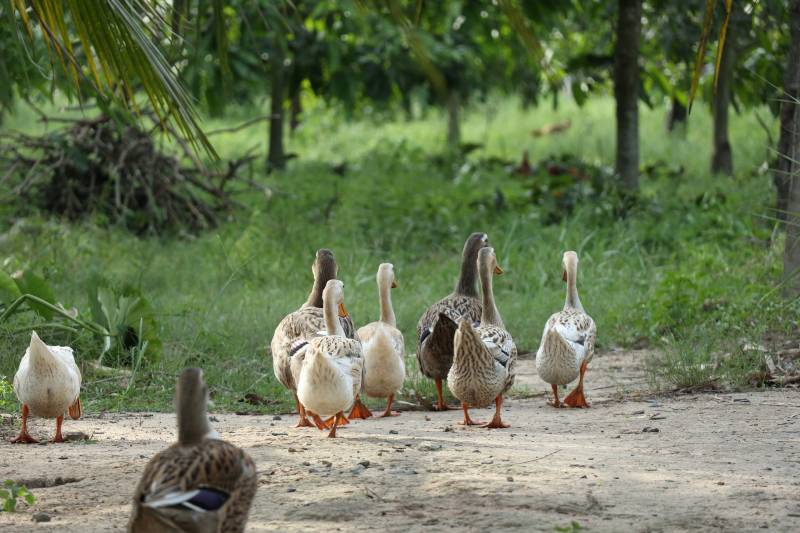Quick Navigation
Domesticating ducks such as Muscovy ducks, Runner ducks, and Mallard ducks in the backyard have always been enjoyable and rewarding.
Ducks have amazingly sturdy bodies but weak, small feet.
Most duck breeds are introverts and very good at hiding their illnesses and injuries from their guardians.

Leg and foot problems are typical happenings in raising a duck.
You’ll know your duck has foot or leg problems if it lies on the ground, is limp when walking, and is reluctant to go in the water.
This brief guide will thoroughly explain everything related to duck leg problems and how to address those problems.
Common Duck Leg Problems
Ducks can quickly go from skittishly jumping to limping and lying on the ground all the time.
Any leg or foot problems can cause undesirable pain to the ducks.
Ducks prefer not to walk and calmly lay down to lessen the pain.
Hence, if you happen to witness your duck laying more calmly than usual, pay attention to its legs and feet.
Ducks’ leg and foot problems are generally associated with an unbalanced diet, poor sanitation, stagnant water, and mismanagement of ducks.
Following are the leg or foot problems duck breeds commonly experience:
Spraddle Leg
Spraddle leg is usually a cause of pain in baby ducks. As ducks have small legs and feet to handle big fat bodies, sometimes their legs can’t handle their weight.
When baby ducks (1 or 2-day-old ducklings) run on smooth or slippery floors, they sometimes lose their footing.
Spraddle legs in ducks and other avian species can also be caused by abnormalities during incubation or hatching.
Baby ducks aren’t able to get enough friction on the slippery floor.
Their tiny legs slide to one side and prevent their normal leg muscle development.
What To Do About Duck Spraddle Leg
In the case of spraddle legs, baby ducks (ducklings) will most probably need your attention and assistance:
- Lay down your duckling on a rubber drawer or cabinet mat to provide enough friction/traction.
- Gently hold the baby duck’s spraddle leg and bring it back to its natural position.
- Keep holding the baby duck’s spraddle leg until the joint and ligaments get completely healed and strengthened.
- You can also use a rubber band, masking tape, and band-aid to keep the leg straight in a natural position.
- Be gentle and put the pad between its spraddle leg. Neatly wrap the band-aid or masking tape around the leg.
- Wait for two to three days to heal the joint and ligaments.
Niacin Deficiency
In baby ducks’ (ducklings) diets, niacin is a significant vitamin.
It helps ducklings and goslings in their proper development.
If ducklings show signs including bowed legs and/or enlarged hock joints they may suffer from this deficiency.
Lack of niacin in ducks’ diets can cause reluctance to move, swelling of hocks, and development of bowed-shaped legs.
With bowed-shaped legs, ducks find it uncomfortable to move.
Lack of niacin could also cause ducks not to gain weight.
How To Address Niacin Deficiency
If not provided with enough niacin in the diet, ducklings will find it very difficult to walk. A lack of niacin could even cause death.
Add a sufficient amount of niacin to your ducks’ diets.
You can easily purchase niacin pills from any nutrition or drug store near your area.
Hopefully, one pill of niacin (500 mg) will be enough to feed 50 ducks.
To make sure, niacin sticks to the pellets, add a sufficient amount of water as well with the food.
Alternatively, you can also mix a niacin pill directly into the drinking water of the ducks.
Simply mix one pill of niacin with 8 gallons of water.
Make sure your ducks drink all the niacin water.
Bacterial Infections
Your duck may be limping and suffering pain because of bacterial infections.
Gross mismanagement of ducks can cause the duck’s hock to swell.
The duck will face difficulty in walking and will most probably limp.

Swelling of the ankle or hock can disturb the natural gait (ability to walk).
If the treatment is not carried away immediately, swelling caused by bacterial infections may completely distort the hock joint.
In such a case, your duck may never recover back to normal walking.
How To Address Bacterial Infections
Visiting your veterinarian to have the infected ducks tested is the best way to identify the bacteria that causes the infection.
The most effective antibiotic injection for the particular infection type can be administered if you consult directly with your vet.
Injured Legs
Ducks are easily cut, bit, and scraped. They can get injuries in many common possible ways.
They may injure or hurt their legs, when they enter or exit water or walk on hard surfaces,
It is also possible, that they may get injuries when your ducks’ tiny feet are cut by a wire.
Such injuries may cause your duck to limp.
Injured Legs Treatment In Ducks
- Firstly, separate your injured duck from its flock.
- Bring your first-aid kit.
- Lightly wash the injured area with mild soap and water.
- You can also rinse the wound with vinegar and water solution.
- Gently disinfect the wound.
- Tenderly bandage or cover it up.
In case your duck is bleeding heavily, immediately bring it to a vet.
Consult Your Vet Regarding Leg Issues
You should consult your veterinarian before deciding to take things into your hands.
Be aware that some duck leg problems may need your vet to splint or hobble it.
Such situations might not be appropriate for you to handle.
Your duck may also require proper physical therapy exercises. In this context, your vet will be a better person to handle the issue.
Let your vet evaluate your duck leg problem and decide on a cure for it.
It is always better to be safe about your duck’s weak legs than to be sorry.
Improper handling may make primary leg problems worse or result in additional duck health issues.
Conclusion
To conclude, if you see your duck limping or walking unnaturally, figure out the cause first.
Try to diagnose and handle the problem if you see fit. But if you see that things are rather severe and out of your expertise, consult a vet.

Purrfect n’ Pawesome is the brainchild of Amanda, who has been into researching and writing about pets to help other pet parents in nurturing their adorable pets. Currently, she runs Purrfect n’ Pawesome along with her team of experienced and dedicated pet experts. Along with being an awesome writer and entrepreneur, Amanda is a cat mom to two innocently spoiled cats, Balanca and Scruffy.
She has been writing about pet care and nurturing and wants to share her readers’ experiences, learnings, and knowledge.
Over the years, she had the opportunity to work with various pet owners having multiple breeds, and that exposure gave her experience and the lessons of a lifetime.
Her family, her entire universe revolves around her two cats, who give her endless support and inspiration to move ahead with her objectives in life. Amanda is a live example of a balanced approach to all parenthood questions we all face in life.






